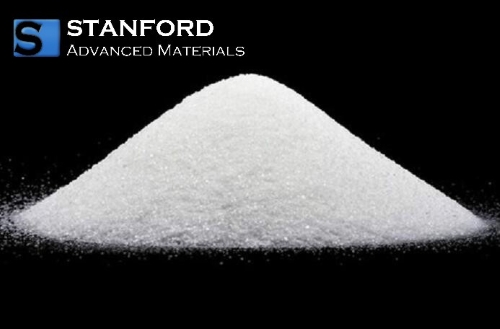Cesium Carbonate: Properties, Applications, And Synthesis
Introduction
Cesium carbonate (Cs2CO3) is an inorganic compound used in chemistry, materials science and various industrial processes. It appears as a white, hygroscopic powder. It dissolves readily in water and organic solvents. Owing to its strong basicity and solubility, cesium carbonate is employed as a catalyst, as a reagent in organic synthesis and as an additive in multiple electronic and optical applications.
 [1]
[1]
Chemical and Physical Properties
Cesium carbonate has the molecular formula Cs2CO3 and a molar mass of 325.82 g/mol. It is a white, hygroscopic powder that absorbs moisture from the air. It dissolves easily in water and forms a strongly basic solution, thereby meeting the requirements for reactions that need a strong base. The compound has a melting point of approximately 610 °C and decomposes on further heating.
Main Characteristics:
- Molecular Formula: Cs2CO3
- Molar Mass: 325.82 g/mol
- Appearance: White, hygroscopic powder
- Solubility: Highly soluble in water, methanol and other polar solvents
- Basicity: Strong base with a pKa value appropriate for deprotonation reactions
- Decomposition: Decomposes at elevated temperatures with the release of CO2

Synthesis of Cesium Carbonate
Cesium carbonate can be synthesised using various methods, including direct reactions and precipitation techniques:
- Reaction of Cesium Hydroxide with Carbon Dioxide:
- CsOH + CO2 → Cs2CO3 + H2O
- In this procedure, carbon dioxide gas is bubbled through a cesium hydroxide solution, thereby causing the precipitation of cesium carbonate.
- Reaction of Cesium Salts with Alkaline Carbonates:
- CsCl + Na2CO3 → Cs2CO3 + NaCl
- In this method, cesium chloride reacts with sodium carbonate followed by purification steps to yield pure cesium carbonate.
Applications of Cesium Carbonate
Due to its strong basicity, solubility and catalytic properties, cesium carbonate is applied in various fields, including organic synthesis, electronics and pharmaceutical research.
1. Organic Synthesis
Cesium carbonate is widely used as a base in organic chemistry for reactions that require a non-nucleophilic, strong base. Its primary roles include:
- Catalyst in Coupling Reactions: It is utilised in palladium-catalysed cross-coupling reactions such as Suzuki, Heck and Sonogashira reactions. These reactions are essential for the synthesis of complex organic molecules in pharmaceutical and materials science research.
- N-Alkylation and O-Alkylation Reactions: Cesium carbonate facilitates the alkylation of amines, alcohols and phenols; this yields ethers and secondary amines.
- Cyclisation Reactions: It promotes intramolecular cyclisation reactions that form heterocyclic and macrocyclic compounds.
2. Electronic and Optical Applications
Cesium carbonate is employed in advanced materials research, particularly in the manufacture of optoelectronic devices.
- Organic Light-Emitting Diodes (OLEDs): Cs2CO3 is used as the electron injection layer (EIL) in OLEDs, thereby enhancing electron transport and efficiency.
- Perovskite Solar Cells: It is incorporated as an additive in perovskite solar cells to improve efficiency and stability.
- Thin-Film Transistors: Cesium carbonate is applied as a dopant or interfacial layer in thin-film transistor technologies, thereby supporting charge transport.
3. Pharmaceutical Industry
- Synthesis of Pharmaceuticals: Cesium carbonate is used in pharmaceutical research for the development of new drug molecules. It is particularly appropriate for reactions that require selective deprotonation or nucleophilic substitutions.
- Peptide Coupling Reactions: In certain peptide bond formations, the use of cesium carbonate increases yield and selectivity.
4. Polymer Chemistry
- Polymer Functionalisation: Cs2CO3 is used to modify polymer surfaces and structures. This process enhances conductivity, thermal stability and mechanical performance.
- Catalyst for Polymerisation Reactions: Cs2CO3 functions as a catalyst in polymerisation processes, thereby facilitating the formation of high-performance polymers.
Safety and Handling
Although cesium carbonate is generally considered safe for use in laboratory and industrial settings, certain precautions should be observed:
- Hygroscopic Nature: It absorbs moisture from the air and should be stored in airtight containers to prevent degradation.
- Strong Alkalinity: It is a strong base and may cause skin or eye irritation. Appropriate personal protective equipment (PPE) such as gloves, safety goggles and a laboratory coat should be worn.
- Environmental Aspects: When disposing of cesium carbonate, local regulations must be followed to avoid contamination of water sources and ecosystems.
Overview Table for Cesium Carbonate
|
Property/Application |
Details |
|
Chemical Formula |
Cs2CO3 |
|
Molar Mass |
325.82 g/mol |
|
Appearance |
White, hygroscopic powder |
|
Solubility |
Soluble in water, methanol and polar solvents |
|
Basicity |
Strong base |
|
Decomposition |
Releases CO2 at high temperatures |
|
Main Applications |
Organic synthesis, electronics, pharmaceuticals, polymers |
|
Key Reactions |
Cross-coupling, alkylation, cyclisation |
|
Safety Precautions |
Hygroscopic; strong base; requires PPE |
Conclusion
Cesium carbonate is a versatile compound with significant applications in organic synthesis, electronics, pharmaceuticals and materials science. Its strong basicity, high solubility and catalytic properties render it a useful reagent in various chemical transformations.
Stanford Advanced Materials (SAM) supplies high-purity cesium carbonate (Cs2CO3) for a range of applications, including organic synthesis, electronics and pharmaceuticals. Its solubility and basicity support performance in catalytic and optoelectronic applications. Choose Stanford Advanced Materials if you require a product that meets your specific requirements.
Reference:
[1] Cesium Carbonate. (09/01/2025). In Wikipedia. https://en.wikipedia.org/wiki/Caesium_carbonate

 Bars
Bars
 Beads & Spheres
Beads & Spheres
 Bolts & Nuts
Bolts & Nuts
 Crucibles
Crucibles
 Discs
Discs
 Fibers & Fabrics
Fibers & Fabrics
 Films
Films
 Flake
Flake
 Foams
Foams
 Foil
Foil
 Granules
Granules
 Honeycombs
Honeycombs
 Ink
Ink
 Laminate
Laminate
 Lumps
Lumps
 Meshes
Meshes
 Metallised Film
Metallised Film
 Plate
Plate
 Powders
Powders
 Rod
Rod
 Sheets
Sheets
 Single Crystals
Single Crystals
 Sputtering Target
Sputtering Target
 Tubes
Tubes
 Washer
Washer
 Wires
Wires
 Converters & Calculators
Converters & Calculators
 Write for Us
Write for Us

 Chin Trento
Chin Trento



